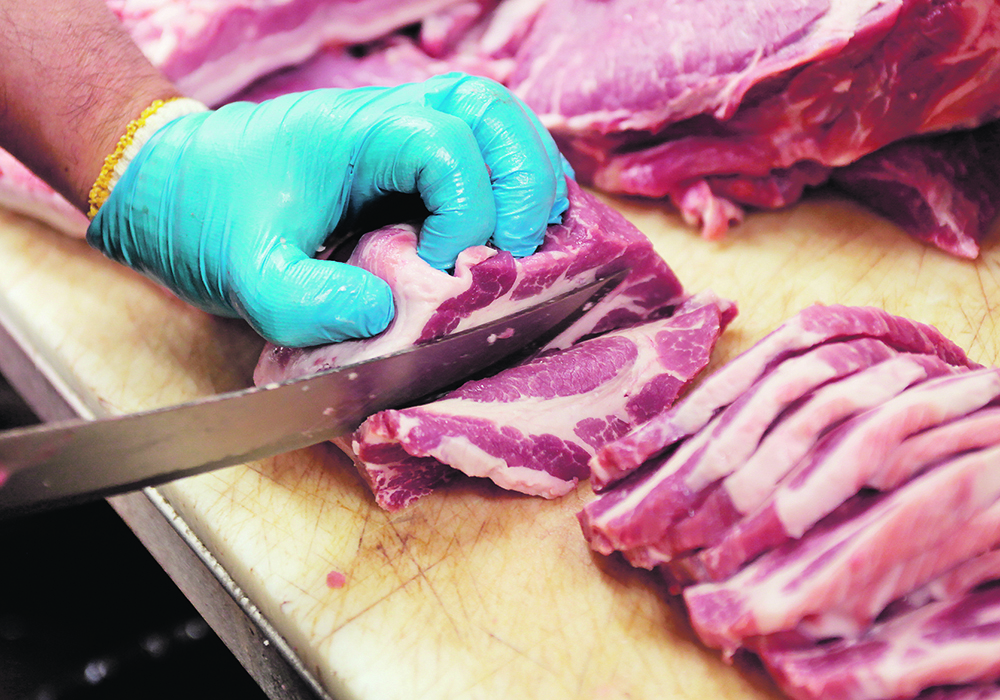U.S. pork consumption declined to 51.7 pounds per capita in 2020 from 59.1 lb. in 1960; Canada is expected to be similar
Pig producers need to improve the taste of the pork they raise if they want to combat long-term declines in consumption and market share, said an expert.
“If we’re going to drive demand, we’ve got to deliver a better eating experience to our customers,” said Jim Long, president and chief executive officer of Genesus Inc. The company, which owns much of the registered purebred breeding stock in Canada, has shipped pigs to more than 36 countries.
Long was one of the speakers at Alberta Pork’s Nov. 24 annual general meeting in Calgary. He said Canadian consumption of pork has likely been similar to that of Americans, which was 59.1 pounds per capita in 1960 in the United States, or 35 percent of all meat consumed.
Read Also

Canadian Food Inspection Agency extends chronic wasting disease control program consultation deadline
Date extended for consultation period of changes to CWD program
However, it declined to 51.7 pounds per capita as of 2020, or 23 percent of all meats. It occurred even as overall consumption of meat increased, said Long.
“While people eat more meat, we have lost market share. We have to ask why. Why have we? If we had 35 percent today, it’s another 50 million pigs in Canada and the United States to meet that demand.”
He pointed to the “Pork. The Other White Meat” advertising campaign in the U.S. in the late 1980s, which promoted pork as an alternative to chicken.
“We needed to produce pork more like beef,” he said.
“We’re a red meat. We’re not chicken. Why would you ever market something to a cheaper product? Chicken’s always cheaper than pork. Why couldn’t we chase beef, which is three times the price or whatever? It’s just, to me, it was a fundamental mistake.”
The pork that Genesus is working to produce is red meat, he said, pointing to a plant in Lethbridge “that has worked really hard at having better pork. They’re one of the few plants I’m aware of that actually recognizes producers for producing better quality, and that is about the characteristics of better eating attributes.”
He said these include marbling, colour, higher water-holding capacity — “that’s the juice” — and tenderness. He singled out work being undertaken in Alberta at the federal Lacombe Research and Development Centre, which he recently visited.
Genesus is working with the centre to identify factors such as the appropriate percentage of back fat or marbling relative to muscle, he said.
“They’ve got tremendous facilities, they’re smart people, they are driven to make a better product… it’s one of the best in the world. Utilize it.”
Long said the people attending the annual general meeting included some of the best pig producers in the world.
“You are as good as anybody… and this isn’t an easy market in Alberta. We have some things to work against.”
However, he has heard too many times from farmers that they need to get more money for their pork.
“But you know how you get more money? You have more demand. If you’re selling more pork, you push that up, you get more money.”
Canadian producers export 70 percent of their pork to foreign markets, he said. Japanese officials recently toured Canada to do random on-farm audits in connection with programs such as PigSAFE under the Canadian Pork Council’s Canadian Pork Excellence platform, said Brent Moen, chair of Alberta Pork.
“What do the Japanese want?” Long asked the farmers at the meeting. “If we can put a better product out there, we own that space.”
Pork producers must start thinking less like farmers and more like marketers focused on figuring out and fulfilling the preferences of their customers, he said.
“How many (of you) go into a restaurant and want to order a pork chop?” he said.
“I know I don’t. You know why? Because I don’t want to be (angry) and sad by the crap that we sometimes deliver.”
However, he dismissed initiatives such as plant-based Beyond Meat burgers that aim to replace meats such as pork, describing how about three years ago “every meeting you went to, we’re all going to go bankrupt … we were hearing about we’re a bunch of losers, the plant-based stuff is going to kill us, OK, whatever.”
He learned otherwise after his son worked at a McDonald’s restaurant during the push for plant-based burgers.
“He said when you’re cooking it, it stinks.”
Long said despite efforts by marketers, plant-based meats have a story, but no product, which is a lesson for the pork industry.
“We have to have a story with a product, and we can do it. And that’s how we can make our businesses sustainable and growing.”
















